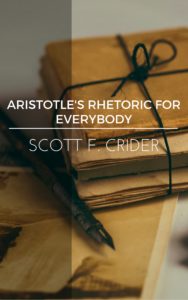Rhetoric
Introductory Course
This is an introduction to the art of rhetoric, written from the perspective of Aristotle—that is, if he were a contemporary American with an interest in old books. Think of it as a simplified, Aristotelian account of the art, simplified since I will avoid almost all Greek terminology, I will not feel obligated to cite Aristotle all the time, instead paraphrasing, and I do not plan on weighing in on arcane, scholarly disputes about this or that. The appendices offer sources for more advanced study. I intend this as an introduction for those who want to know what rhetoric is and who may have an interest in Aristotle. You may want to improve your writing, your reading, your speaking, and/or your listening. Aristotle always improves your thinking. Indeed, when Adler divides Aristotle’s overall concerns into three general categories—making, doing, and thinking—he explains that each is actually a form of thinking: thinking about making, thinking about doing, and thinking about thinking. As we will see, rhetoric concerns all three: Since it is a productive art, rhetoric asks us to think about “making” speech; since that made speech occurs in social settings (intimate and civic), rhetoric asks us to think about “doing” ethical and political things with it; and since that made-speech for ethical and political purposes is intimately related to philosophy, it is often theoretical. Every rhetoric, no matter how concerned with technique or virtue, assumes a theory of rhetoric. Aristotle’s Rhetoric, then, takes up all three subjects of making, doing and thinking about language. . .
-Scott F. Crider, The University of Dallas
Advanced Course
As its subtitle indicates, this book, in the first of its two major parts, treats types of thinking, first developed by select authors in the ancient Greco-Roman world, about rhetoric––that is, verbal suasion or psychagogy. (The term, meaning the verbal guidance of soul, is Plato’s.) Homer, Aeschylus, Plato, Aristotle, Cicero, and Virgil have fashioned the types of rhetorical thinking this book examines and, to be candid, promotes as beneficial and necessary today. To avoid confusion for the reader in the pages to come, the word “rhetoric” will usually mean thought about verbal psychagogy and all related to it, which, as we will see, includes the basic concerns of human welfare. A second, more restricted sense is the art of managing language for the purpose of psychagogy in any verbal form whatsoever, written or spoken, as, for example, in the rhetoric of the memorandum, love letter, lyric poem, novel, lecture, public speech, or conversations of all sorts. These will be the two primary senses of the word in this book.
There are other senses of the word also. That rhetoric means only civic oratory (public speaking) or the art of oratory is common today and was so also in antiquity. But this very narrow sense of the word will be of only minor importance, and the introductory remarks below will show the reader why. Of course, rhetoric can also mean self-serving or partisan speech, often involving verbal duplicity and fraud. These pejorative senses of the word were very common both in antiquity and in modern times.
Considered overall, the book presents a basic claim: that the rhetorical thinking of these ancient writers, though not in all respects the same, differed in two essential ways from the thinking of most other writers in the ancient rhetorical tradition and nearly all in the contemporary world of scholarly academics and educators. First, their thinking differed in that for the ills of life caused by strife, delusion, and deceit, all of them sought a reality-based verbal remedy, often called truth or wisdom or justice or right when recognized and spoken. Some (Homer, Aeschylus, and Virgil) sought the remedy through their life and work as poets. Others (Plato, Aristotle, and Cicero) did likewise by participating in a way of life and speech they, with various understandings, called philosophy. Second, in spite of the complicity of speech in the ills of life, these writers showed an exceptionally keen valuation of human language owing to what in human nature came to be called psyche or soul––what made human beings distinctive among all other beings in the world in using and responding to speech.
In the contemporary world, rhetorical thinking of the ancient types treated here is nearly moribund because a real, common wisdom or truth upon which to draw is discounted as culture-bound and thus cannot be common at all, and because psyche (usually “soul” in English) is thought of as a fiction for brain function, thus not as the non-material source and ontological basis of humanity that functions as the internal governor of human life and that, because non-material, suggests also what our relation to higher “divine” beings may be, and what consequences regarding our relations to such divinity may follow. As a result, the types of rhetorical thinking treated here are strangers in the land of contemporary higher learning. The wisdom sought here combines many academic disciplines (as they are conceived today), is identifiable with no one of them, and moves thought about language and its effects on human behavior in a metaphysical and theological direction rejected by the physical and social sciences and many contemporary understandings of philosophy. In fact, both contemporary paradigms of academic thought and many of the persistent realities of human nature and history are powerfully antagonistic to the types of ancient rhetorical thought this book presents.
But there is one field of bright flowers in this rough contemporary landscape. There does exist today a great deal of academic scholarship about ancient rhetoric as a legitimate field of historical study, even if it is dismissed in the end as a curious intellectual tradition of little (economic) value. This historical scholarship, although sometimes nearly lifeless, has made it possible to revive phoenix-like from the ashes of irrelevance and dismissal a new and deeper understanding of the great, if limited, hope ancient rhetoric offers. Such revival is the chief reason for this book. These matters will be again discussed later in this prologue and elsewhere in this book.
What follows is some introductory information about the subject of the book, rhetoric (taken in its two primary senses); the parts of the book; some of the important tenets connected to its basic claim; its form or genre as an essay (and not a history); and a fuller statement of why it was written––that is, the hope represented by the rhetorical thinking this book examines.
-Raymond DiLorenzo†, The University of Dallas
"1. Rhetoric is the art of speaking well in civil cases, for the purpose of persuading people toward the just and good. Rhetoric is named from the Greek term ρητοριζειυ, that is, fluency of speech, for ρητοις in Greek means “speech,” ρητωρ means “orator." –St. Isidore of Seville (The Etymologies of Isidore of Seville, II.i)
“Moreover...there is to my mind no more excellent thing than the power, by means of oratory, to get a hold on assemblies of men, win their good will, direct their inclinations wherever the speaker wishes, or divert them from whatever he whatever he wishes. In every free nation, and most of all in communities which have attained the enjoyment of peace and tranquility, this one art has always flourished above the rest and ever reigned supreme….[T]he wise control of the complete orator is that which chiefly upholds not only his own dignity, but the safety of countless individuals and of the entire State.” –Cicero (De Oratore I, 30-34).
“Since rhetoric is used to give conviction to both truth and falsehood, who could dare to maintain that truth, which depends on us for its defense, should stand unarmed in the fight against falsehood? This would mean that those who are trying to give conviction to their falsehoods would know how to use in an introduction to make their listeners favorable, interested, and receptive, while we would not; that they would expound falsehoods in descriptions that are succinct, lucid, and convincing, while we would expound the truth in such a way as to bore our listeners, cloud their understanding, and stifle their desire to believe… No; oratorical ability, so effective a resource to commend either right or wrong, is available to both sides; why then is it not acquired by good and zealous Christians to fight for the truth, if the wicked employ it in the service of iniquity and error, to achieve their perverse and futile purposes.” –Augustine (On Christian Teaching IV.4-5).


